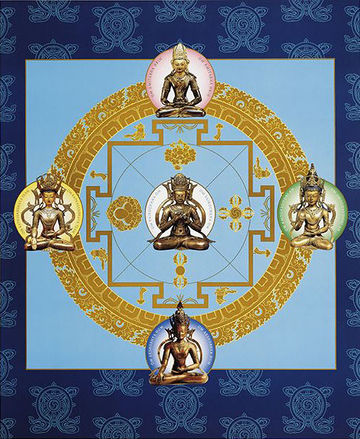Mandala

Mandala is a Sanskrit word meaning “circle,” translated in Tibetan texts as “center” or “what surrounds.” Some say the word derives from manda, meaning “essence.” A mandala is a group, company or assembly; a circle of friends; an assembly or gathering of Buddhas and Bodhisattvas. Also a circular design containing images of deities symbolizing the universe, totality, or wholeness; used in meditation by Hindus and Buddhists.
In Tibetan Buddhism
Traditionally mandalas are painted on thangkas (scroll paintings framed in silk), drawn with colored sand, represented by heaps of rice, or constructed three-dimensionally, often in cast metal.
Mandalas were originally composed on the ground in front of the meditator and are therefore oriented toward the person who is contemplating them. The point nearest the contemplator, at the bottom of the mandala, is the east. The mandala continues clockwise, following the course of the sun, with south to the left of the contemplator, west at the top and north to the right.
Lama Anagarika Govinda, one of the foremost interpreters of Tibetan Buddhism to the West, explains:
In the same way as the sun rises in the east and thus begins the day, the practitioner enters the mandala through the eastern gate, the door in front of which he sits.[1]
The mandala as a circle denotes wholeness, completeness and the perfection of Buddhahood. A mandala is a sacred, consecrated space where no obstacles, impurities or distracting influences exist. Buddhists use it as an aid in meditation and visualization. “All mandalas,” writes Tibetologist Detlef Lauf, “originate from the seed-syllables, or bija-mantras, of the deities. During meditation upon these mantras, an elemental radiance of light develops, from which comes the image of the Buddhas.”[2]
Symbolism
Mandalas are rich in symbolism. “Mandalas appear as circles around a holy center,” write authors Blanche Olschak and Geshe Thupten Wangyal. “These depictions are the ground plan of the visionary heavenly abodes, at whose center is manifested the holy power that is to be invoked. The entire mandala is a fortress built around this Buddha-force.”[3] In his meditation the disciple circles the focus at the center of the mandala until he can finally integrate with that powerful nucleus.
The disciple uses the mandala to find its elements within himself. Writes religious historian Mircea Eliade:
As soon as he has entered the mandala, he is in a sacred space, outside of time; the gods have already “descended” into the ... insignia. A series of meditations, for which the disciple has been prepared in advance, help him to find the gods in his own heart. In a vision, he sees them all emerge and spring from his heart; they fill cosmic space, then are reabsorbed in him.... By mentally entering the mandala the yogi approaches his own “center.”... The yogi, starting from this iconographic “support,” can find the mandala in his own body.[4]
Thus with all its symbolism, a mandala is no mere external image of heavenly power. Buddhists believe a mandala is the receptacle of the holy power it portrays. Its purpose, and the goal of every one of its symbolic images, is to help the meditator realize the divine power within himself and achieve his own inner perfection.
The Dalai Lama teaches:
Mandala, in general, means that which extracts the essence.... The main meaning [of a mandala] is for oneself to enter into the mandala and extract an essence in the sense of receiving blessing. It is a place of gaining magnificence.[5]
For the disciple who knows how to use it, a mandala is therefore a map of the progressive steps to self-transformation and mystic union. It represents the growth of the seed of Buddhahood within him. “The meditator,” says Lama Govinda, “must imagine himself in the center of the mandala as an embodiment of the divine figure of perfect Buddhahood.” And that Buddhahood, he says, “can only be found in the realization of all those qualities which, taken all together, form the richness of the mandala.”[6]
See also
Sources
Elizabeth Clare Prophet, “Introduction to the Five Dhyani Buddhas and Their Mandala,” Pearls of Wisdom, vol. 37, no. 2, January 9, 1994.
Pearls of Wisdom, vol. 36, no. 46, October 6, 1993.
- ↑ Lama Anagarika Govinda, Insights of a Himalayan Pilgrim (Berkeley: Dharma Publishing, 1991), p. 128.
- ↑ Detlef Ingo Lauf, Secret Doctrines of the Tibetan Books of the Dead, trans. Graham Parkes (Boston: Shambhala, 1989), p. 105.
- ↑ Blanche Christine Olschak and Geshe Thupten Wangyal, Mystic Art of Ancient Tibet (Boston: Shambhala, 1987), p. 36.
- ↑ Mircea Eliade, Yoga: Immortality and Freedom, 2d ed., trans. Willard R. Trask, Bollingen Series, no. 56 (1969; reprint, Princeton, N.J.: Princeton University Press, 1970), p. 225.
- ↑ The Fourteenth Dalai Lama His Holiness Tenzin Gyatso, Kindness, Clarity, and Insight, ed. Jeffrey Hopkins and Elizabeth Napper (Ithaca, N.Y.: Snow Lion Publications, 1984), p. 82.
- ↑ Lama Anagarika Govinda, Foundations of Tibetan Mysticism (1960; reprint, New York: Samuel Weiser, 1969), p. 181; Insights of a Himalayan Pilgrim, p. 178.
